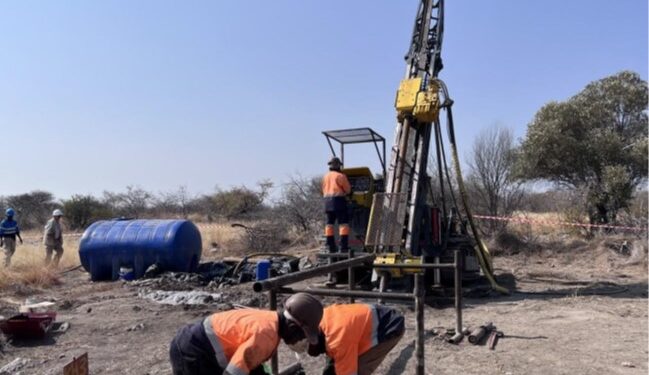Golden Deeps Limited (ASX:GED) has commenced a seven to nine hole, >2,000m diamond drilling programme targeting extensions and/or repeats of its very high-grade Khusib Springs copper-silver deposit in Namibia.
The Khusib Springs deposit was a “blind” discovery, in the early 1990s by Goldfields Ltd. Drilling in the upper part of the now mined deposit included spectacular intersections such as: KH006 4.5m at 35.19% Cu, 3.67% Pb, 2.23% Zn, 2091 g/t Ag from 30m2 KH008 14.0m at 8.12% Cu, 0.75% Pb, 0.52% Zn, 385 g/t Ag from 37m.
The initial discovery went into production from 1995, closing in the early 2000s having produced ~300,000t of ore at a very high grade of 10% copper (Cu) and 584g/t silver (Ag). The mined deposit terminated against a steeply dipping wrench-fault at around 300m depth.
Further drilling was carried out to south of the fault and at depth, intersecting copper-silver mineralisation from around 400m depth and producing drilling intersections that included: KH66: 2.5m @ 2.13% Cu, 468 g/t Ag from 375m incl. 0.2m @ 12.1% Cu, 2,796 g/t Ag. However, due to the low prevailing copper price at the time the deeper mineralisation was not followed up and the decline based mine remained closed.
A study in 2020 by South Africa based geological consultancy Shango Solutions, on behalf of Golden Deeps, highlighted potential for remnant, open-pitable mineralisation above the mined Khusib Springs deposit. Copper mineralisation is evident at surface within this zone. Shango also identified potential for the offset extensions of the Khusib Springs deposit to be located to the south and at depth across the offsetting wrench fault.
Further interpretation and modelling of the Khusib Springs deposit indicates that this very high-grade copper-silver sulphide orebody is associated with a flexure in the dolomite / host platy limestone contact, that is offset by the wrench fault that is interpreted to have displaced the deposit in a right lateral/normal sense.
The new drilling programme comprises:
- Two shallow diamond drillholes testing the upward projection of the high-grade copper-silver zone. These holes will target remnant, open-pitable mineralisation above the exceptionally high-grade mineralisation that was stoped below ~30m depth and below the copper mineralisation that is evident at surface.
- ii) Two diamond drillholes testing a second flexure in the contact approximately 200m along strike to the northeast of the existing deposit, targeting a repeat of this discrete high-grade massive sulphide deposit.
- iii) Three to five deeper diamond drillholes that will test for the offset extension of the Khusib Springs copper-silver orebody at depth to the south of the normal/wrench fault Downhole electromagnetics (DHEM) is planned to test the extent of in-hole and/or off hole conductors in the vicinity of these planned holes.
“Following careful planning we have now commenced this very exciting diamond drilling programme testing for extensions or repeats of the very-high-grade Khusib Springs copper-silver orebody,” CEO Jon Dugdale, said.
“Previous drilling has already shown that the high-grade mineralisation continues south of a major wrench fault and we are looking to test that zone to the west and down-plunge with both drilling and geophysics.
“At the same time as the drilling we will carry out a deep penetrating electromagnetics programme to detect other blind massive sulphide zones along strike – which we will look to drill test during the current programme.
“Discovery of extensions or a repeat of this very high-grade copper-silver orebody would be a major breakthrough for the Company and provide a springboard to re-establishing production from the existing decline at the Khusib Springs Mine.”
For further information please visit: https://www.goldendeeps.com/












